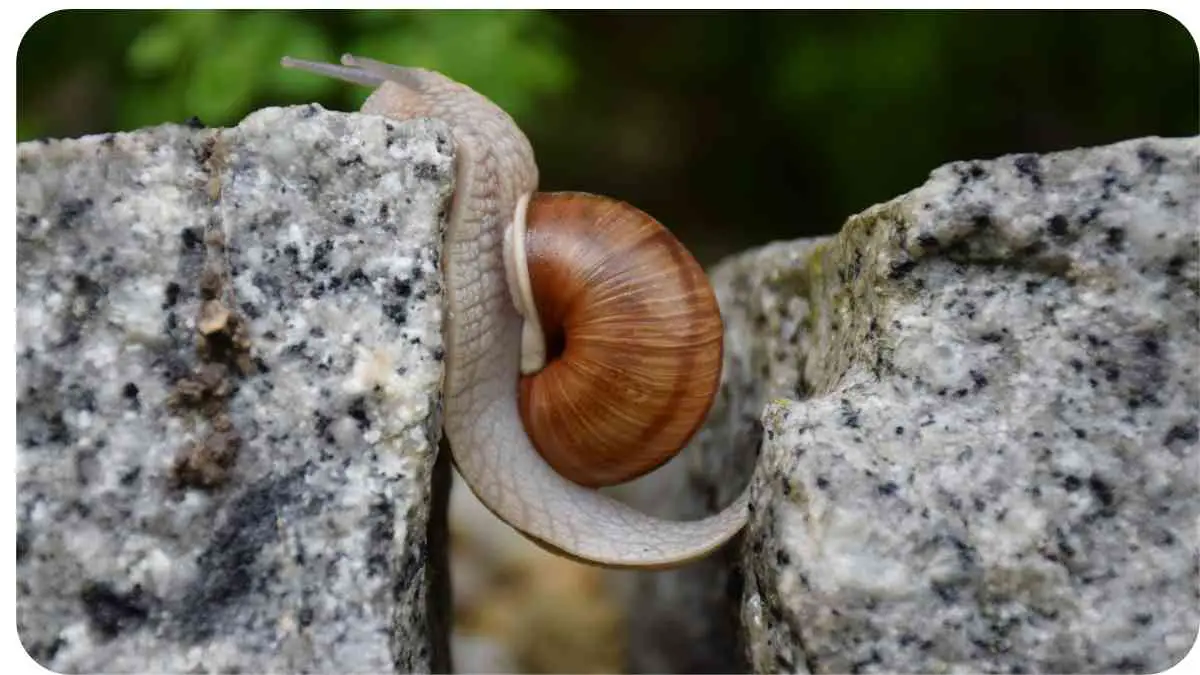Aquaponics enthusiasts often encounter the challenge of managing snail populations in their gardens. While snails can be beneficial, their overgrowth may lead to concerns. Discover effective strategies to control snails in your aquaponics system and maintain a thriving, balanced environment.
| Key Takeaways |
|---|
| Snails can be beneficial in an aquaponics system, but can also become a pest if their population grows too large. |
| Preventative measures, such as using copper tape around the edges of the tank and using a filter to remove snail eggs, can help keep snail populations under control. |
| If snail populations do become too large, manual removal or using a natural predator, such as a pea puffer fish, can be effective. |
| Chemical treatments should only be used as a last resort and with caution, as they can harm other organisms in the system. |
| Regular monitoring and maintenance of the aquaponics system can help prevent snail populations from getting out of control in the first place. |
Manual Removal Techniques

1.1 Thorough Snail Hunt with a Bucket
Utilize a bucket to physically locate and eliminate snails. This method is highly effective for small infestations, demanding a meticulous search for potential hiding spots.
1.2 Net Sweeping Strategy
Opt for a net to safely remove snails, avoiding direct contact. Easily accessible at aquarium supply stores or fish markets, sweeping it over plants and the fish tank efficiently captures unwanted creatures.
Are you interested in learning more about aquaponic gardening? Our article on what is an aquaponics system and how do they work? provides a comprehensive introduction to the system and explains how it works. It’s a great place to start if you’re new to aquaponics and want to learn more.
Snail Trapping Techniques
Snail traps play a crucial role in capturing and relocating snails within your aquaponics system.
2.1 Attract and Contain with Baited Traps
Harness the power of snail traps by utilizing bait to attract these creatures. Once lured in, a gate mechanism efficiently contains them. Ensure proper disposal post-capture to prevent the release of unwanted pests into nature or your property.
2.2 Snail Trap Options and Considerations
- Beer Traps: Cost-effective and easy to make, requiring constant replenishment.
- Predatory Traps (e.g., Assassin Snails): Offers a permanent solution but may harm other aquatic life.
- Copper Strips: Works well in the long-term with a moderate initial cost.
- Potato Traps: Affordable and easy to make, but needs regular refreshing.
- Citrus Traps: Natural and effective, though results can be inconsistent.
| Snail Trap | Cost | Pros | Cons |
|---|---|---|---|
| Beer Traps | Low | Easy to make | Need constant replenishment |
| Predatory Traps (e.g. Assassin snails) | High | Offers permanent solution | Can harm other aquatic life |
| Copper Strips | Medium | Works well in the long-term | Initial cost might be high |
| Potato Traps | Low | Cheap and easy to make | Needs to be refreshed regularly |
| Citrus Traps | Low | Natural and can be effective | Inconsistent results |
In aquaponic gardening, snail infestations can be quite common and can
Predatory Allies in Snail Control
3.1 Introduction of Natural Predators
Harness nature’s balance by introducing various predators to control snail populations in your aquaponics system. Consider:
- Ducks, Geese, and Chickens: Efficient ground foragers that can help control snail numbers.
- Frogs and Toads: Amphibian allies in managing snail populations.
- Saltwater Fish (e.g., Bluegill, Bass, Catfish): Effective aquatic predators.
3.2 Monitoring Predator Effectiveness
Carefully observe the behavior of introduced predators to assess their impact on snail populations. Recognize that it might take time for them to adapt to the new environment before significantly reducing snail eggs or juveniles. Patience is key to allowing these natural allies to establish their role in controlling snail infestations.
Boiling Water Intervention
4.1 Swift Snail Removal with Boiling Water
In cases without a fish tank but armed with a large pot of boiling water, a direct approach can be employed. Pouring boiling water into the affected area will effectively eliminate snails, ensuring their disappearance by the following morning.
4.2 Cautionary Measures
Exercise caution to prevent harm to fish:
- Ensure the water temperature is not excessively high to avoid injuring the fish.
- Be mindful not to spill boiling water on yourself or in undesired areas.
4.3 Timing for Optimal Results
For optimal effectiveness, execute this method either before sunrise or after sunset, minimizing sunlight exposure for an extended period. This swift intervention offers a practical solution to promptly address snail overpopulation.
If you’re curious about the different types of vegetables you can grow in an aquaponic garden, check out our article on what vegetables can be grown in aquaponics?. It provides valuable insights on the types of plants that can thrive in an aquaponic system and is a great resource for anyone looking to diversify their crop.
Copper Shield Against Snail Invasion
5.1 Utilizing Copper as a Protective Barrier
Deploy copper as a potent barrier to ward off snails from infiltrating your growbed. Snails find copper toxic, prompting them to avoid it, making it an effective deterrent.
5.2 Copper’s Effectiveness and Limitations
While copper is particularly effective against slugs and certain pond snail species, it may not universally deter all snail varieties. Understanding its limitations ensures strategic use.
5.3 Synergistic Defense
Optimize the efficacy of copper by combining it with other deterrents such as Sluggo and Diatomaceous Earth (DE). This layered defense approach enhances protection, creating a robust shield against snail intrusion in your aquaponics system.
| Copper Barrier | Cost | Pros | Cons |
|---|---|---|---|
| Copper Tape | Low to Medium | Easy to install | Regular maintenance required |
| Copper Mesh | Medium | Durable and long-lasting | High initial cost |
| Copper Foil | Medium | Effective for smaller areas | Limited coverage area |
| Copper Netting | High | Durable and versatile | Expensive option |
Balanced Fish Nutrition for Snail Control
6.1 Pitfall of Overfeeding
A prevalent error among aquaponics enthusiasts is the tendency to overfeed fish. While ensuring proper nutrition is crucial, excess food results in increased waste, fostering a rise in snail populations within your system.
6.2 Strategic Feeding Approach
Mitigate snail proliferation by adopting a strategic feeding approach:
- Less, More Often: Feed fish smaller amounts more frequently to minimize excess waste production.
- Enhance Filtration with Plants: Integrate more plants into the system to absorb fish waste, providing an additional nutrient source and maintaining a balanced ecosystem.
6.3 A Holistic Approach to Aquaponic Harmony
By moderating fish feeding practices and incorporating additional greenery, you create a harmonious aquaponic environment that discourages snail overgrowth and promotes overall system health.
Shielding Growbeds with Row Covers
7.1 Effective Snail Prevention with Row Covers
Utilize row covers as a reliable defense against snails infiltrating your aquaponics system. Choosing the appropriate type is crucial for success.
7.2 Strategic Placement
Implement the following steps for optimal effectiveness:
- Early Deployment: Place row covers over growbeds before planting commences.
- Extended Coverage: Maintain covers throughout the growth cycle until harvest time.
- Temperature Consideration: Optionally remove covers during warmer periods, ensuring nighttime temperatures remain above 40 degrees Fahrenheit (4°C).
7.3 Year-Round Protection
Decide whether to leave row covers in place throughout the year or adapt based on temperature fluctuations. This preventative measure enhances the resilience of your aquaponic setup against snail intrusion, promoting sustained system health.
Maintaining good water quality is crucial to the success of an aquaponic garden. Our article on how often do you have to change the water in aquaponics? offers practical advice on how often you need to change the water in your system to keep your plants healthy and prevent snail infestations.
Sustaining Cleanliness for Snail Control

8.1 Prioritize Regular Maintenance
A pivotal aspect of managing snails in your aquaponics system is maintaining regular cleanliness.
8.2 Snail Attraction to Waste
Snails are drawn to ammonia and nitrites produced by decaying fish waste and plant debris. They often attach to growbeds and plants, facilitating their spread if not addressed promptly.
8.3 Tank Cleaning Techniques
- Surface Skimming: Use a magnet net or screen mesh to remove snails gathered on the tank surface, preventing them from reattaching to walls.
- Fish Removal for Thorough Cleaning: Safely remove fish using nets and buckets, then meticulously clean and rinse all equipment before reassembly.
8.4 Growbed Maintenance
- Aeration and Filtration: Set up an old aquarium filter with an airstone or a pump to enhance water circulation and filtration.
- Strategic Placement: Position the filter near plant growth areas, aiding in the removal of waste that drains into gravel beds.
| Frequency | Tasks |
|---|---|
| Daily | Observe fish and plants for any signs of sickness or infestation. Check water temperature, pH level, and dissolved oxygen. |
| Weekly | Clean the fish tanks and remove any dead fish or debris. Test the water for ammonia and nitrate levels. |
| Monthly | Flush the grow bed to remove any unwanted solids. Clean filters or media beds. Check pipes for any signs of blockages or leaks. |
| Quarterly | Empty and clean the sump tank. Inspect the system for worn or damaged parts. Check the electrical connections. |
| Annually | Conduct a comprehensive system overhaul. Replace worn or damaged parts. Deep clean the entire system. |
Humidity Regulation for Snail Prevention
9.1 Controlling Snails through Humidity Management
Initiate the battle against snails by regulating humidity levels within the tank. Snails thrive in excessively humid conditions, making humidity reduction a key preventive measure.
9.2 Monitoring Humidity with a Hygrometer
Ensure optimal humidity levels by using a hygrometer, available at hardware stores for $15-$20. Regularly check both growbeds and fish tanks for accurate readings.
9.3 Cautionary Measures
- Dehumidifier Usage: If humidity is too high, consider employing a dehumidifier to reduce moisture levels.
- Avoid Extreme Cooling: Exercise caution with air conditioners, preventing excessively cold temperatures that could harm essential bacteria colonies vital for proper plant growth.
Are snails causing problems in your aquaponic garden? Our article on are snails good for aquaponics? explains how snails can be beneficial to your garden under certain circumstances and offers strategies to keep them under control. Learn more about the role of snails in your aquaponic system and how to manage them effectively.
Taming Snail Temptations: Vegetation Control
10.1 Mitigating Snail Attraction to Overgrowth
Snails are drawn to overgrown vegetation and weeds, making cleanliness crucial in snail prevention within your aquaponics system.
10.2 Key Maintenance Practices
- Weed Management: Regularly trim and control the growth of vegetation to eliminate snail habitats.
- Debris Removal: Keep the aquaponics system free of debris, including the fish tank.
- Biological Filter Optimization: Ensure a well-developed and active biological filter to efficiently break down ammonia and nitrites.
10.3 Addressing Biological Filter Inefficiencies
A poorly functioning biological filter can contribute to ammonia and nitrite accumulation, posing a risk to plant and fish health and potentially leading to snail infestations. Prioritize the optimization of the biological filter to maintain a balanced and thriving aquaponic ecosystem.
Organic Debris Elimination for Snail Control
11.1 Snail Population Prevention
Snails, with their rapid reproduction, can swiftly overrun your aquaponics system if left uncontrolled.
11.2 Effective Prevention Measures
- Debris Removal: Regularly eliminate organic debris from both the tank and growbeds.
- Algae Management: Clear any algae growth on surfaces to minimize snail habitats.
- Inspect Growbeds: Thoroughly examine growbeds for potential snail infestations.
11.3 Vigilant Inspection Techniques
- Nighttime Check with Flashlight: Use a flashlight at night to spot potential hiding spots, especially under rocks or wood chips.
- Addressing Potential Hiding Places: Be proactive in removing hiding spots to thwart snail proliferation.
11.4 Insect Control for Comprehensive Prevention
Combat potential insect carriers by using tweezers to remove them before they become entangled in the flourishing plant life. This comprehensive approach ensures a well-maintained and snail-resistant aquaponics environment.
Review Your pH Levels and Make Adjustments as Needed
Before you get started with your snail-killing regimen, it’s important to make sure that your water is at the right pH level.
pH refers to the measure of how acidic or alkaline your water is on a scale of 0-14. Lower numbers indicate higher acidity and higher numbers indicate higher alkalinity.
Snails are less likely to reproduce in water with low pH levels (less than 7) and will die off more quickly in high-pH waters (higher than 8).
If you suspect your aquaponics system has too many snails because they’re multiplying faster than they should be, adjusting your system’s pH may help control them better.
If not, try some other methods like using chemical controls instead!
Maintaining good water quality in your aquaponic garden is essential to the health of your plants and fish. Check out our article on the aquaponics biofilter explained to learn more about the importance of the biofilter in maintaining good water quality and how to ensure it’s working effectively.
Conclusion
In conclusion, managing snails in your aquaponics system requires a multifaceted approach that combines proactive prevention, vigilant maintenance, and strategic intervention.
By implementing measures such as removing organic debris, controlling overgrowth, optimizing filtration systems, and introducing natural predators, you can effectively curb snail populations and maintain a healthy ecosystem. Additionally, utilizing commercial snail traps and monitoring the system for any signs of resurgence provide supplementary avenues for control.
With dedication and a comprehensive strategy, you can overcome snail challenges and cultivate a flourishing aquaponics system conducive to plant growth and fish health.
Further Reading
Here are some additional resources that you may find helpful if you are interested in learning more about aquaponics:
How Do You Use Aquaponics at Home? Find Out!: This article provides an overview of how to set up and maintain an aquaponics system in your home.
How Do You Grow Vegetables in Aquaponics?: This article explains which types of vegetables are best suited for aquaponics and provides tips for growing them.
How to Make Your Own Aquaponics System: This article provides step-by-step instructions for building your own aquaponics system.
What Vegetables Can Be Grown in Aquaponics?: This article provides a list of vegetables that are suitable for growing in an aquaponics system.
How Often Do You Have to Change Water in Aquaponics?: This article provides guidance on how frequently you should change the water in your aquaponics system to maintain optimal conditions.
Aquaponics System Explained: This video provides a visual overview of how an aquaponics system works and the benefits it can offer.
How to Build an Aquaponics System: This video provides a step-by-step guide on how to build your own aquaponics system.
FAQs
What is aquaponics?
Aquaponics is a system of aquaculture that combines the cultivation of fish and plants in a symbiotic environment. Waste produced by the fish is broken down by bacteria and transformed into nutrients that are used by plants to grow. In turn, the plants filter the water and provide a clean environment for the fish.
How does aquaponics work?
In an aquaponics system, fish are raised in a tank and their waste is pumped into a plant bed where it is broken down by bacteria and transformed into nutrients. The plants absorb these nutrients and use them to grow, while also filtering the water and providing a clean environment for the fish.
What types of plants can be grown in aquaponics?
Many types of vegetables, herbs, and fruits can be grown in an aquaponics system, including lettuce, tomatoes, peppers, cucumbers, strawberries, and more.
What types of fish can be raised in aquaponics?
Many types of fish can be raised in an aquaponics system, including tilapia, trout, catfish, and more. The choice of fish will depend on factors such as water temperature, pH levels, and the type of plants being grown.
What are the benefits of aquaponics?
Aquaponics offers several benefits, including the ability to produce both fish and plants in a small space, reduced water usage, and the ability to grow crops year-round in a controlled environment. It is also a sustainable and environmentally friendly method of food production.

For 15 years, Hellen James has worked in the gardening industry as an expert and landscape designer. During her career, she has worked for a variety of businesses that specialize in landscaping and gardening from small firms to large corporations.

